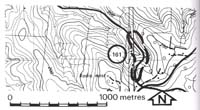161. Almurta East - Mesozoic Sediments
|
This information has been developed from one or more of these publications:
|
Location: | Jeetho - 802410. Road cuttings on the Glen Alvie Road eight kilometres south-east of Almurta. |  Massive arkose (A) overlying thin-bedded mudstone, Strzelecki Group, Almurta East. |
Access: | Glen Alvie Road. | |
Ownership: | Crown Land. | |
Geology: | The road cuttings expose a clear eight metre section of Mesozoic sediments. The lower three metres are a sequence of soft thin sandstones and thicker mudstones, the upper part of the section is predominantly irregularly bedded arkose with slump and scour structures well displayed. | |
Significance: | Regional. This is one of the few accessible inland sites that display a relatively unweathered Mesozoic sequence. | |
Management: | Class 2. No artificial stabilisation or regarding of the slope should be undertaken as this would mask the significant features of the exposure. | |



